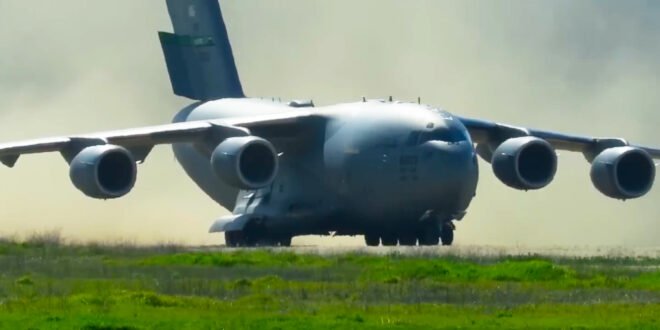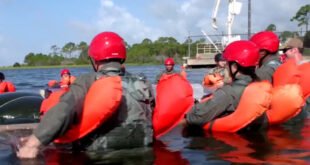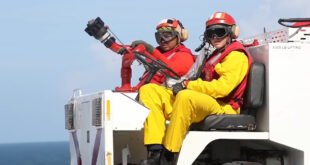Discover the amazing US technique to land huge planes in the middle of the desert. Explore the mysteries of these desert landings in this fascinating video!
The military’s air mobility operations are intricate and demand a high degree of cooperation and preparation. This is particularly true in situations with difficult circumstances, like inclement weather or difficult terrain.
This is the reason an Air Mobility Liaison Officer plans and leads these missions. He serves as a communication link between the airlift, which includes transport aircraft, helicopters, and aerial refueling planes, and the ground forces. In order for ground commanders to comprehend the logistics underlying unit movements and actions, an AMLO must collaborate closely with them.
They are also aware of supply drops and airlift capabilities. This is the reason that pilots and navigators with experience in airlift operations typically hold this role. They did, however, receive additional instruction centered on radio communications and air mobility rules and regulations.
This training goes deeper by having the officials practice using airlift systems such as the single mobility system and the intra-theater airlift request system. Their work has significantly increased the efficacy and efficiency of ground force maneuvers and supply drops. In really harsh settings, like in a desert, this work can become very taxing.
Typically, the Air Mobility Command officer and their team reconnoitre the terrain and evaluate possible landing sites. In order to accomplish this, the crew looks for obstacles of any type, assesses the surface conditions, and locates characteristics in the landscape that serve as orientation points. The crew employs several instruments as safety precautions to assess the topography and ensure that a large aircraft, such as a C-17, can land or take off from the runway.
The pilots can use a probe known as a soil penetrometer to find out if the soil is stable enough to support the weight of the aircraft. The special operations airmen delineate the landing strip’s boundaries using visual markers like cones, flags, or painted lines once the site has been determined. Special operations airmen typically employ dirt bikes for this process because these markers require quick placement across great distances.
They are useful in reconnaissance and surface preparation duties because of their agility, which guarantees that the landing strip is prepared to facilitate military airlift in these kinds of situations. Landing in grass takes the same preparation and dedication as in a desert area, yet with less challenging and hostile terrain. A contingency reaction group is responsible for creating the landing grounds from the ground up for grass landings.
In order to give pilots advice, the airfield management finds an ideal location and labels it using protocols similar to those for those four other kinds of terrain. The landing of tactical transport aircraft, such as the C-130 and C-146, serves as one illustration. These aircraft can use makeshift or harsh landing strips.
This apparatus, which is mounted in front of the plane’s wheels, aids in dispersing the weight across a greater surface area. They keep the airplane from sinking into the snow and function well in deep, recently fallen snow.
It demonstrates how maintaining a clean runway is essential, even in such a dangerous setting. It is crucial to supply the necessary services and provide support under all circumstances in order to sustain the aircraft’s operations, whether they be for military operations, scientific research, rescue and emergency missions, or supply transportation. For regions like the Arctic that rely solely on air transportation for supply delivery, this support is essential.
The converted LC-130 is the mainstay of supply trips to the Arctic sites because of its arctic equipment. The crew inspects the equipment of the aircraft before it takes off northward to ensure it is prepared for the mission. Concurrent with this procedure is an assessment of the destination’s weather conditions to make sure there won’t be any snowstorms or other events.
The destination gets the landing strip ready while the aircraft is in the air to guarantee that the cargo lands undamaged. When using these kinds of runways in remote areas, additional care needs to be taken when taking off and landing. In order to verify that there are no obstructions during the approach and landing, pilots must check with the ground teams.
Nevertheless, they need to figure out the safest route to the location and the proper descending angle. The weight of the aircraft, the length of the runway, the elevation, the temperature, and the wind speed are all taken into account. Pilots may even optimize their runway navigation by employing strategies, such as soft-field or short-field landing methods.
Not all atypical takeoffs and landings, meanwhile, take place in hostile environments far from populated areas. Roads and highways can serve as emergency runways in certain situations. When conventional airports are not close by, these roads might offer pilots a practical alternative for carrying out essential operations.
Pilots receive training to handle these kinds of circumstances, so they become accustomed to them. The crew is ready when they board their aircraft because of briefings and mission preparation, which enable them to know the proper configuration to operate. Through exercises like Northern Strike, they have demonstrated this by testing A-10 Thunderbolt highway landings.
Through these training activities, individuals can improve their skills and knowledge of aircraft capabilities, which can lead to the development of new technologies and methods to further enhance these qualities. The goal of exercises like the Obsidian Iceberg exercise is to create and validate methods and protocols for nodal amphibious operations. Here, we evaluate new systems in remote areas for conditions related to takeoff and landing.
The fifth-generation fighter F-35B, with its STOVL system, is an example of this. That speaks to this F-35 variant’s ability to take off quickly and land vertically. It does away with the requirement for conventional runways by enabling the aircraft to land or take off from a short runway, even taking off vertically if there is no payload.
The advancement of technology has made it possible to use more adaptable strategies and techniques in military operations. This includes carrying out operations from impromptu, tiny landing zones like helipads, narrow streets, or amphibious assault vessels. To comprehend these updated systems, F-35B pilots must complete the training exercises and simulations.
With this information, they can use various techniques to maximize aircraft performance in difficult circumstances and manage short-field or rough-field landings. The capacity to carry out landings in challenging conditions is essential for emergency response, military operations, and humanitarian aid. By equipping themselves with the necessary abilities, resources, and expertise to perform these landings, pilots can accomplish their mission goals. This concludes the video. I hope it was enjoyable for you. To ensure that you don’t miss any of our upcoming content, please subscribe to this channel. View more posts
 DailyDiscovery
DailyDiscovery





